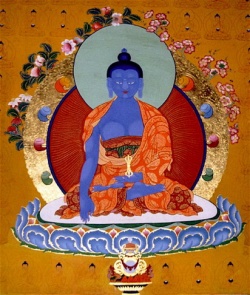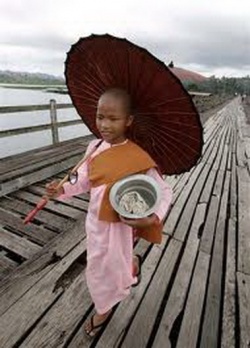Negative Depictions and Positive Contributions of Women in Theravada Buddhism
By Rev. Patti Nakai
Part Two: Negative Depictions and Positive Contributions of Women in Theravada Buddhism
The historical Buddha, Shakamuni, enjoyed a life of complete freedom. He did not pursue or cling to luxuries that were unessential to his basic survival, but he also did not make a big fuss trying to avoid or refuse those things when he encountered them. However, in the earliest form of Buddhism, called Theravada (also known as Hinayana), there was a conscious effort to emulate the Buddha's sparse lifestyle as closely as possible. The ever-increasing amount of rules and regulations came to be known as the Vinaya. As all scholars of Buddhism are quick to point out, there were many more rules for women than for men; in one version, there are about 250 rules for monks and 348 rules for nuns.
Nuns and the Vinaya
Why were nuns more restricted than monks when, in Buddha's lifetime, the Sangha had transcended society's view of women as inferior? One reason, I think, was the way society treated nuns as opposed to monks. A monk going to meditate in the woods carrying only a begging bowl of table scraps would be an unlikely target for muggers. But nuns, wherever they went, were subjected to much harassment; the verbal taunts about their chastity, which Indian society considered unnatural, sometimes escalated into physical assault. Probably because of several violent incidents, monks were asked to chaperone nuns in their various activities in and out of the nunnery. The monks may have started out in the spirit of giving assistance to their sister disciples, but the Vinaya rules requiring a male presence at the nuns' religious ceremonies only reinforced the prejudiced view that women were unable to make any kind of spiritual progress without the guidance of men.
In an English translation of the Vinaya that I looked through at Otani University, I was surprised that many of the rules for nuns were about avoiding any behavior that could be taken as sexually suggestive. Some rules about what not to do were so graphic that it read more like someone's X-rated fantasies than guidelines to feminine modesty. This aspect of the Vinaya reflects the belief in ancient India that, because women existed mainly to please men and have babies, they were much more sex-driven than men. Due to this belief, the compilers of the Vinaya felt women needed many and more specific rules about controlling their sexuality than men did.
Women as Objects of Revulsion
I think most women would agree with me that it seemed to be the monks who had a problem with sex, rather than the nuns. This would explain why a large part of Theravada texts is devoted to the depiction of women as disgusting creatures too repulsive to touch.
A good analogy to this situation is the desperate dieter trying to imagine all food as oozing, rotting substances too nauseating to eat. Since sexual desires were considered a great hindrance in the striving for enlightenment, the monks believed the only way to eliminate their desire was to make the objects of their attachment less attractive in their minds. The historical Buddha used this approach in some instances. There was a courtesan who became a Buddhist follower and donated all her wealth to the Sangha. However, many males in the Sangha were too obsessed with her beauty and reputation to see her as a fellow disciple. When she died, the Buddha had her corpse put on display for those disciples and told them to observe the process of decay so that they would see how transient the qualities of beauty and sexuality were. Towards the woman herself, though, Buddha meant no disrespect - he knew that during her last years she had been a sincere follower of the Teachings. The problem for the Theravada monks was that in psyching themselves into seeing women's bodies as repulsive, they also came to see all other aspects of women as unworthy, making it increasingly difficult for monks to relate to nuns as human beings with the same religious aspirations as they had.
The Lost History of Theravada Nuns
According to research by female scholars of early Buddhism such as I.B. Horner, there were a large number of nuns during the first few centuries after Buddha's death. However, due to the growing hostility of secular society and of the monks, nunneries were phased out and eliminated. For almost two thousand years in India, the birthplace of Buddhism, and in Sri Lanka, where it first spread, there were no ordained women. Only in recent times has there been a reappearance of Buddhist nuns inspired by their sisters in other countries.
In the feminist view of world history, the accomplishments of women have been either ignored or appropriated by male-dominated cultures. This could very well be true for the early nuns. The only surviving text of Theravada Buddhism that is positively attributed to nuns is a compilation of songs. Who knows what other works they produced that were lost when Hinduism and Islam drove Buddhism out of favor in South Asia? It is unlikely that the monks trying to keep Buddhism alive were concerned with the works of women when so many other texts needed to be saved from destruction. Yet it is a testament to the nuns' spiritual insight and expressive power that their book of songs was respected enough to be preserved through all the upheavals in South Asia.


